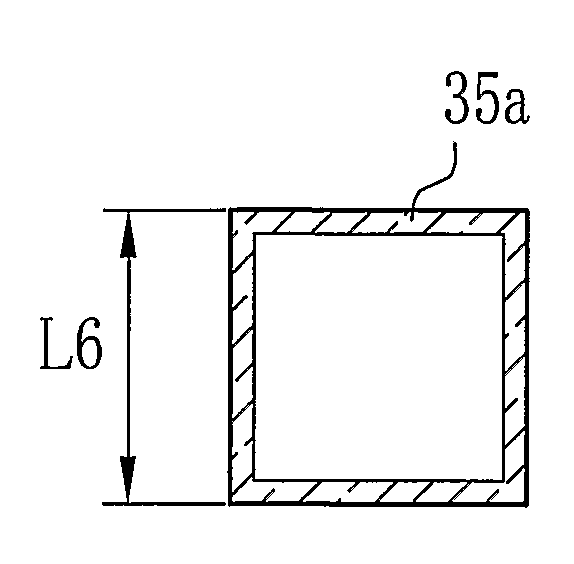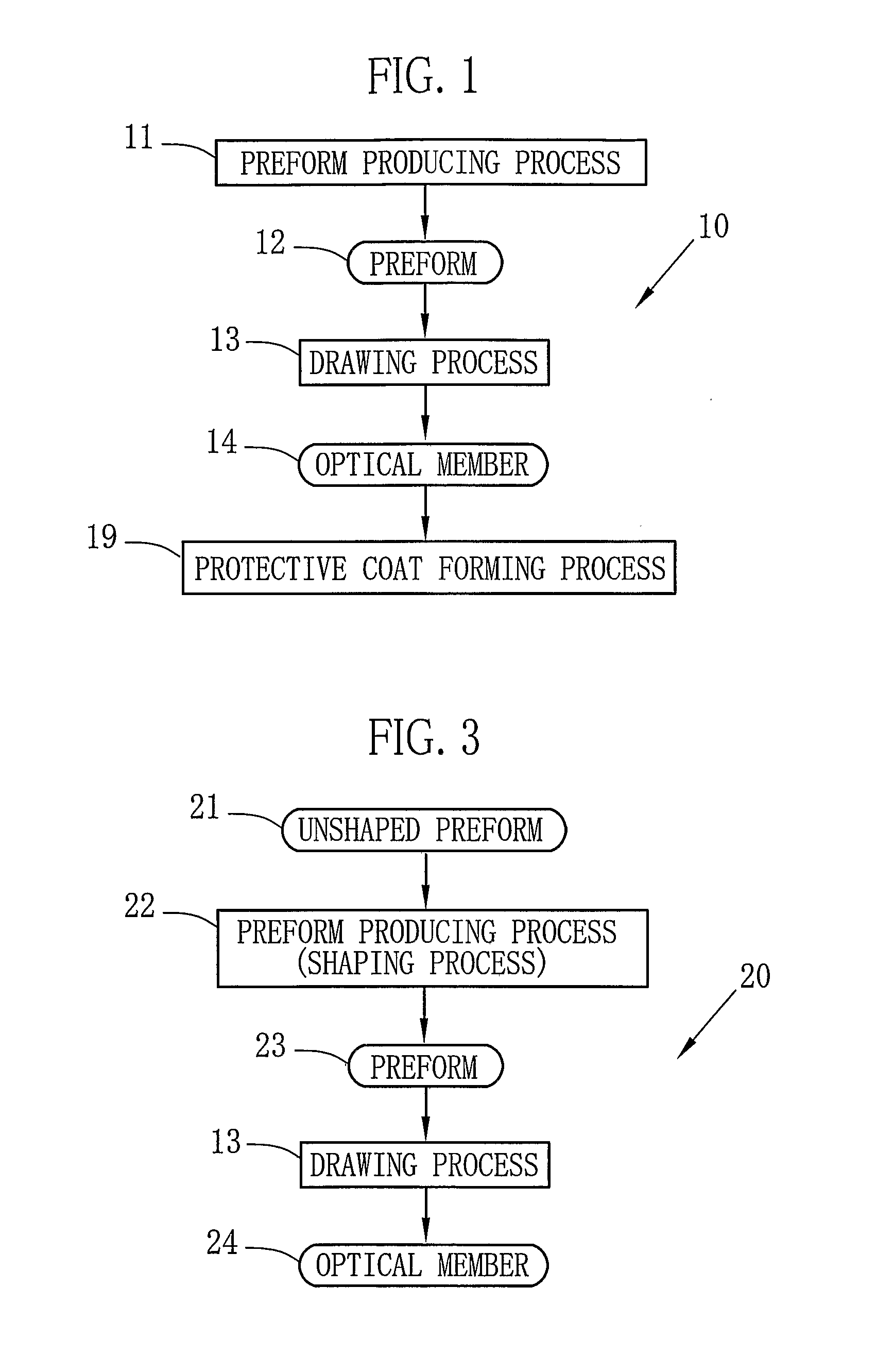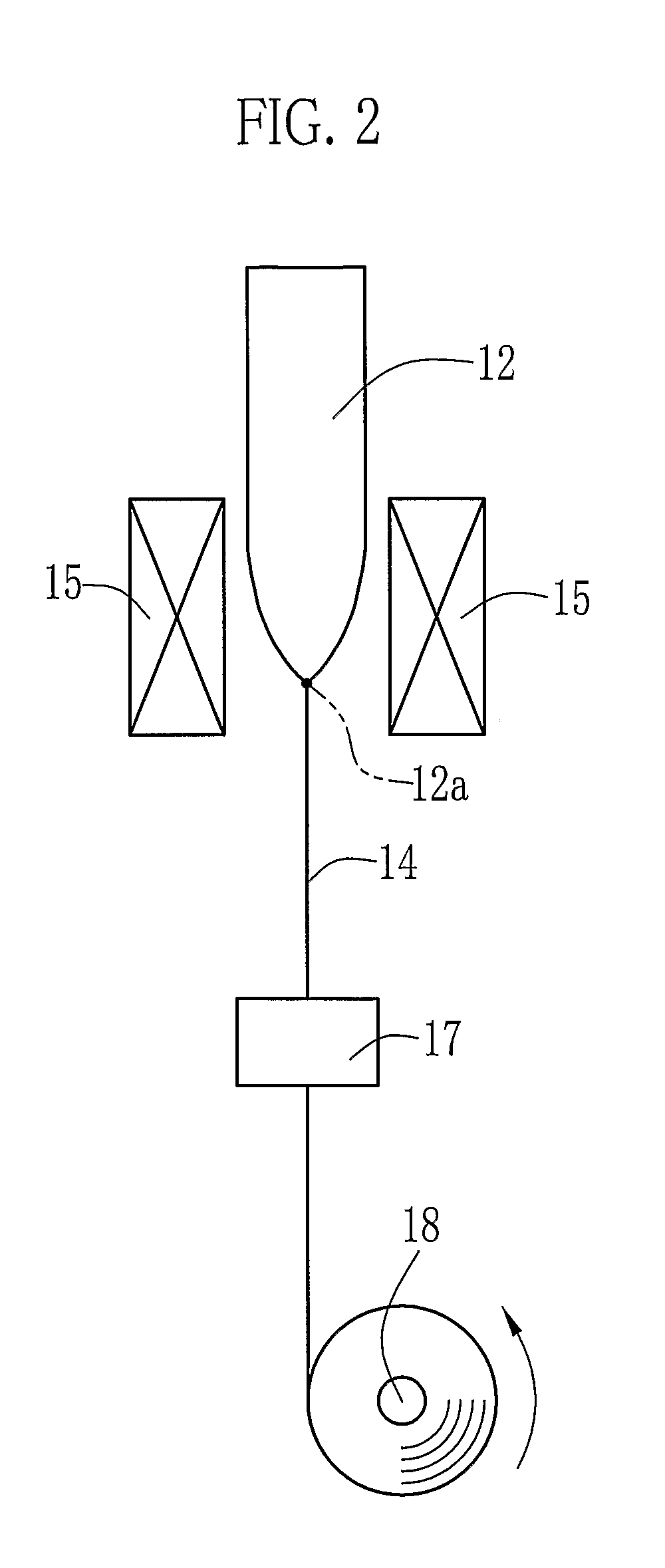Plastic Optical Member and Producing Method Thereof
a technology of optical components and manufacturing methods, applied in the field of plastic optical components, can solve the problems of reducing manufacturing efficiency, increasing manufacturing costs, and reducing manufacturing efficiency, and achieve the effects of easy production, easy production, and easy obtaining of complicated cross-sectional shapes
- Summary
- Abstract
- Description
- Claims
- Application Information
AI Technical Summary
Benefits of technology
Problems solved by technology
Method used
Image
Examples
experiment 1
[0103](Experiment 1)
[0104]In experiment 1, an optical member 14a shown in FIG. 9C was obtained from preform 12 shown in FIG. 9B, by the first process 10 shown in FIG. 1. At first, as shown in FIG. 9A, a square pipe (hereinafter the clad pipe) 70 of 1000 mm length, which has 0.5 mm thickness and a cross-section whose sides L1 are 20 mm length, was provided. The clad pipe 70 became a clad 71a when the optical member 14a was obtained, for keeping transmitting light in a core 72a. The clad pipe 70 was formed of PVDF which is plastic having low refraction index. Note that in this experiment, the clad pipe 70 was formed by the melt-extrusion method.
[0105]Next, in the clad pipe 70, a core 72 was formed as shown in FIG. 9B. Although material of the core 72 is not limited while having optical transparency, it is preferable that optical transmission loss is low. In this experiment, PMMA which is (meth)acrylic acid resin was used. To form the core 72, methyl methacrylate (MMA) or the like was ...
experiment 2
[0106](Experiment 2)
[0107]In experiment 2, an optical bus (sheet bus) which is the optical member 24 was produced by the second process 20 shown in FIG. 3. At first, as shown in FIG. 10A, a cylindrical unshaped preform 21, whose cross-section has the diameter L3 of 20 mm, was produced. The unshaped preform 21 comprises a core 80 and a clad 81. The clad 81 contains light scattering particles (silicon particles, whose average diameter is 1 μm). The core 80 mainly contains PMMA, and the clad 81 mainly contains PVDF. Next, as shown in FIG. 10B, the unshaped preform 21 was sandwiched between two flat plates 82 and 83, and was applied the heat-pressing process to be deformed, in 600 seconds at approximately 200° C. under approximately 0.5 MPa. As a result, the oval preform 23, whose cross-sectional ratio (L5:L4) is 1:4 (9.1 mm×36.4 mm) was obtained. Then in the drawing process 13 shown in FIG. 3, The preform 23 was heat-drawn in the temperature range of the softening point to the melting ...
experiment 3
[0108](Experiment 3)
[0109]In experiment 3, an optical member 33a having four cores whose cross-section is square, as shown in FIG. 11E, was obtained by the third process 30 shown in FIG. 4. At first, in the clad pipe producing process 34 in the preform piece producing process 31, a square clad pipe 35a of PVDF, which has 1000 mm length, 0.5 mm thickness and a cross-section whose sides L6 are 10 mm length, was produced by the melt-extrusion. The clad pipe 35a was inserted in the polymerization container. After the polymerization container containing the clad pipe 12 was washed with pure water, the polymerization container was dried under the temperature of 90° C. Thereafter, one end of the clad pipe 35a was sealed by a Teflon (Registered Trademark) stopper. The inner wall of the clad pipe 35a was washed with ethanol, and then the clad pipe 35a was subject to decompression process (−0.08 MPa to atmospheric pressure) for 12 hours at 80° C. by an oven.
[0110]Next, an outer core polymeriz...
PUM
 Login to View More
Login to View More Abstract
Description
Claims
Application Information
 Login to View More
Login to View More - R&D
- Intellectual Property
- Life Sciences
- Materials
- Tech Scout
- Unparalleled Data Quality
- Higher Quality Content
- 60% Fewer Hallucinations
Browse by: Latest US Patents, China's latest patents, Technical Efficacy Thesaurus, Application Domain, Technology Topic, Popular Technical Reports.
© 2025 PatSnap. All rights reserved.Legal|Privacy policy|Modern Slavery Act Transparency Statement|Sitemap|About US| Contact US: help@patsnap.com



